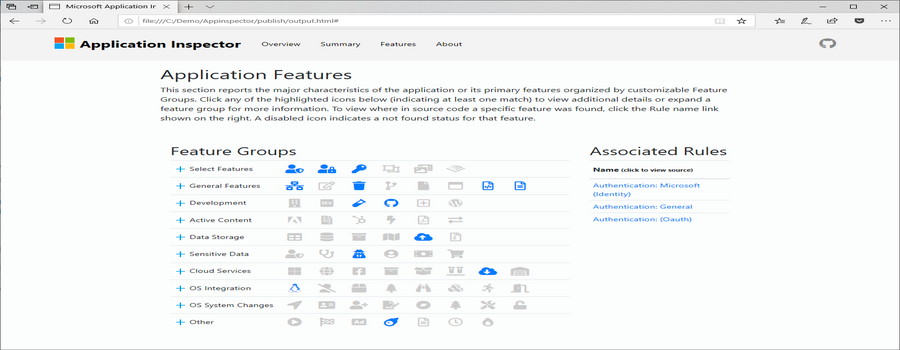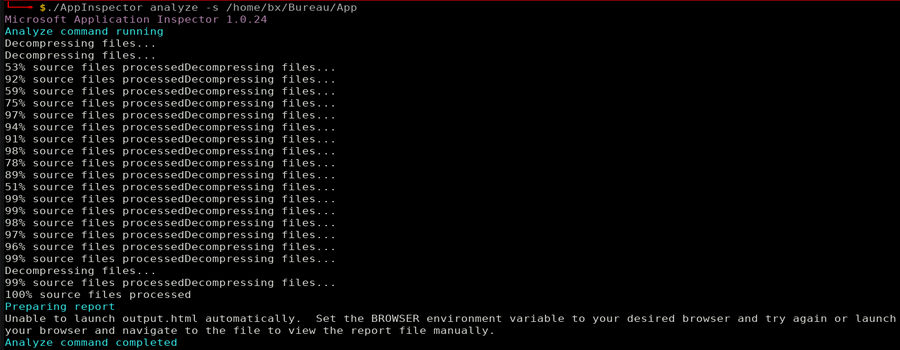Microsoft Application Inspector is a software source code analysis tool that helps identify and surface well-known features and other interesting characteristics of source code to aid in determining what the software is or what it does. It has received attention on ZDNet, SecurityWeek, CSOOnline, Linux.com/news, HelpNetSecurity, Twitter and more and was first featured on Microsoft.com.
Application Inspector is different from traditional static analysis tools in that it doesn’t attempt to identify “good” or “bad” patterns; it simply reports what it finds against a set of over 400 rule patterns for feature detection including features that impact security such as the use of cryptography and more. This can be extremely helpful in reducing the time needed to determine what Open Source or other components do by examining the source directly rather than trusting to limited documentation or recommendations.
The tool supports scanning various programming languages including C, C++, C#, Java, JavaScript, HTML, Python, Objective-C, Go, Ruby, PowerShell and more and includes HTML, JSON and text output formats with the default being an HTML report similar to the one shown here.
It includes a filterable confidence indicator to help minimize false positives matches as well as customizable default rules and conditional match logic.
Be sure to see our project wiki page for more help https://Github.com/Microsoft/ApplicationInspector/wiki for illustrations and additional information and help.
Goals
Application Inspector helps inform you better for choosing the best components to meet your needs with a smaller footprint of unknowns for keeping your application attack surface smaller. It helps you to avoid inclusion of components with unexpected features you don’t want.
Application Inspector can help identify feature deltas or changes between component versions which can be critical for detecting injection of backdoors.
It can be used to automate detection of features of interest to identify components that require additional scrutiny as part of your build pipeline or create a repository of metadata regarding all of your enterprise application.
Basically, we created Application Inspector to help us identify risky third party software components based on their specific features, but the tool is helpful in many non-security contexts as well.
Application Inspector v1.0 is now in GENERAL AUDIENCE release status. Your feedback is important to us. If you’re interested in contributing, please review the CONTRIBUTING.md.
Contribute
We have a strong default starting base of Rules for feature detection. But there are many feature identification patterns yet to be defined and we invite you to submit ideas on what you want to see or take a crack at defining a few. This is a chance to literally impact the open source ecosystem helping provide a tool that everyone can use. See the Rules section of the wiki for more.
Getting Application Inspector
To use Application Inspector, download the relevant binary (either platform-specific or the multi-platform .NET Core release). If you use the .NET Core version, you will need to have .NET Core 3.0 or later installed. See the JustRunIt.md or Build.md files for help.
It might be valuable to consult the project wiki for additional background on Rules, Tags and more used to identify features. Tags are used as a systematic heirarchal nomenclature e.g. Cryptography.Protocol.TLS to more easily represent features.
Usage
Application Inspector is a command-line tool. Run it from a command line in Windows, Linux, or MacOS.
> dotnet AppInspector.dll or on *Windows* simply AppInspector.exe <command> <options>
Microsoft Application Inspector 1.0.17
ApplicationInspector 1.0.17
(c) Microsoft Corporation. All rights reserved
ERROR(S):
No verb selected.
analyze Inspect source directory/file/compressed file (.tgz|zip) against defined characteristics
tagdiff Compares unique tag values between two source paths
tagtest Test presence of smaller set or custom tags in source (compare or verify modes)
exporttags Export default unique rule tags to view what features may be detected
verifyrules Verify rules syntax is valid
help Display more information on a specific command
version Display version information
Examples:
Command Help
Usage: dotnet AppInspector.dll [arguments] [options]
dotnet AppInspector.dll -description of available commands
dotnet AppInspector.dll <command> -options description for a given command
Analyze Command
Usage: dotnet AppInspector.dll analyze [arguments] [options]
Arguments:
-s, --source-path Required. Path to source code to inspect (required)
-o, --output-file-path Path to output file. Ignored with -f html option which auto creates output.html
-f, --output-file-format (Default: html) Output format [html|json|text]
-e, --text-format (Default: Tag:%T,Rule:%N,Ruleid:%R,Confidence:%X,File:%F,Sourcetype:%t,Line:%L,Sample:%m)
-r, --custom-rules-path Custom rules path
-t, --tag-output-only (Default: false) Output only contains identified tags
-i, --ignore-default-rules (Default: false) Ignore default rules bundled with application
-d, --allow-dup-tags (Default: false) Output only contains non-unique tag matches
-c, --confidence-filters (Default: high,medium) Output only if matches rule pattern confidence [<value>,] [high|medium|low]
-k, --include-sample-paths (Default: false) Include source files with (sample,example,test,.vs,.git) in pathname in analysis
-x, --console-verbosity (Default: medium) Console verbosity [high|medium|low|none]
-l, --log-file-path Log file path
-v, --log-file-level (Default: Error) Log file level [Debug|Info|Warn|Error|Fatal|Off]
Scan a project directory, with output sent to “output.html” (default behavior includes launching default browser to this file)
dotnet AppInspector.dll analyze -s /home/user/myproject
Add custom rules (can be specified multiple times)
dotnet AppInspector.dll analyze -s /home/user/myproject -r /my/rules/directory -r /my/other/rules
Write to JSON format
dotnet AppInspector.dll analyze -s /home/user/myproject -f json
Tagdiff Command
Use to analyze and report on differences in tags (features) between two project or project versions e.g. v1, v2 to see what changed
Usage: dotnet AppInspector.dll tagdiff [arguments] [options]
Arguments:
--src1 Required. Source 1 to compare (required)
--src2 Required. Source 2 to compare (required
-t, --test-type (Default: equality) Type of test to run [equality|inequality]
-r, --custom-rules-path Custom rules path
-i, --ignore-default-rules (Default: false) Ignore default rules bundled with application
-o, --output-file-path Path to output file
-x, --console-verbosity Console verbosity [high|medium|low
-l, --log-file-path Log file path
-v, --log-file-level Log file level [error|trace|debug|info]
Simplist way to see the delta in tag features between two projects
dotnet AppInspector.dll tagdiff --src1 /home/user/project1 --src2 /home/user/project2
Basic use
dotnet AppInspector.dll tagdiff --src1 /home/user/project1 --src2 /home/user/project2 -t equality
Basic use
dotnet AppInspector.dll tagdiff --src1 /home/user/project1 --src2 /home/user/project2 -t inequality
TagTest Command
Used to verify (pass/fail) that a specified set of rule tags is present or not present in a project e.g. user only wants to know true/false if crytography is present as expected or if personal data is not present as expected and get a simple yes/no result rather than a full analyis report.
Note: The user is expected to use the custom-rules-path option rather than the default ruleset because it is unlikely that any source package would contain all of the default rules. Instead, create a custom path and rule set as needed or specify a path using the custom-rules-path to point only to the rule(s) needed from the default set.
Otherwise, testing for all default rules present in source will likely yield a false or fail result in most cases.
Usage: dotnet AppInspector.dll tagtest [arguments] [options
Arguments:
-s, --source-path Required. Source to test (required)
-t, --test-type (Default: rulespresent) Test to perform [rulespresent|rulesnotpresent]
-r, --custom-rules-path Custom rules path
-i, --ignore-default-rules (Default: true) Ignore default rules bundled with application
-o, --output-file-path Path to output file
-x, --console-verbosity Console verbosity [high|medium|low
-l, --log-file-path Log file path
-v, --log-file-level Log file level
Simplest use to see if a set of rules are all present in a project
dotnet AppInspector.dll tagtest -s /home/user/project1 -r /home/user/myrules.json
Basic use
dotnet AppInspector.dll tagtest -s /home/user/project1 -r /home/user/myrules.json -t rulespresent
Basic use
dotnet AppInspector.dll tagtest -s /home/user/project1 -r /home/user/myrules.json -t rulesnotpresent
ExportTags Command
Simple export of the ruleset schema for tags representing what features are supported for detection
Usage: dotnet AppInspector.dll exporttags [arguments] [options]
Arguments:
-r, --custom-rules-path Custom rules path
-i, --ignore-default-rules (Default: false) Ignore default rules bundled with application
-o, --output-file-path Path to output file
-x, --console-verbosity Console verbosity [high|medium|low
Export default rule tags to console
dotnet AppInspector.dll exporttags
Using output file
dotnet AppInspector.dll exporttags -o /home/user/myproject/exportags.txt
With custom rules and output file
dotnet AppInspector.dll exporttags -r /home/user/myproject/customrules -o /hom/user/myproject/exportags.txt
Verify Command
Verification that ruleset is compatible and error free for import and analysis
Usage: dotnet AppInspector.dll verifyrules [arguments]
Arguments:
-r, --custom-rules-path Custom rules path
-i, --ignore-default-rules (Default: false) Ignore default rules bundled with application
-o, --output-file-path Path to output file
-x, --console-verbosity Console verbosity [high|medium|low
Simplist case to verify default rules
dotnet AppInspector.dll verifyrules
Using custom rules only
dotnet AppInspector.dll verifyrules -r /home/user/myproject/customrules -i
Build Instructions
Building from source requires .NET Core 3.0. Standard dotnet build commands can be run from the root source folder.
Framework Dependent
dotnet build -c Release
Platform Targeted Portable
dotnet publish -c Release -r win-x86
dotnet publish -c Release -r linux-x64
dotnet publish -c Release -r osx-x64

